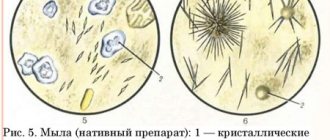From the first days of his life, the digestive system of a newborn child begins to adapt to the new environment, so the baby’s stool constantly undergoes changes, and the mucus that appears in the baby’s stool causes concern among parents. Mucus fragments indicate normal bowel function, but a significant increase in discharge may be a sign of disease. The presence of pathologies is indicated by the color of the stool, the presence of other characteristic symptoms, and the baby’s behavior.
What is mucus in stool
The glands of the adult intestine produce small amounts of a mucous substance to protect the intestinal wall and facilitate the passage of stool. Stool with mucus in a breastfed baby is caused by the immaturity of the enzymatic system and poor functioning of the intestines. If your newborn baby is calm and gaining weight, there is no reason to panic.
At the physiological level, mucus is a clot consisting of products of the secretory work of epithelial tissue cells. The viscous substance performs a protective function due to the content of antiseptics and immunoglobulins. In other words, the appearance of epithelial clots in large numbers indicates that the body is trying to protect itself from some irritating factors.
Why are there white lumps in baby's stool?
White lumps in a baby's stool are a common occurrence. As a rule, they have the appearance of curdled grains.
Do not confuse white grains with white streaks in the stool, which indicate a source of infection in the intestines. If white veins appear, urgent consultation with a specialist is needed!
For breastfed babies, the appearance of white grains usually indicates overeating or high fat content of mother's milk. This will also be indicated by significant weight gain. The previous portion of breast milk had not yet had time to be properly absorbed by the baby’s body when the new one arrived. This causes white specks to appear.
Feces with white lumps in IV (artificial feeding) babies usually appear during the period of diet change. This could be the introduction of a new formula, complementary foods, or a new complementary feeding product. That is why it is important to introduce new products gradually, gradually increasing their quantity by 10 grams. As soon as the white lumps in the baby’s stool disappear, we can say that the child’s body has adapted to the new product. Otherwise, you should choose the mixture that will be more suitable for the child. Often the cause of the appearance of white lumps can also be banal overeating of a bottle-fed baby.
White lumps in a baby's stool appear as an alarm signal:
- For lactose intolerance. At the same time, frequent bowel movements are observed (more than 10 times a day), the feces are very liquid, watery, and foamy. A strict diet is required for a nursing mother, and for a baby, consultation and examination by a specialist. As a result of confirmation of the diagnosis, artificial infants are transferred to lactose-free formulas, and lactase enzymes are added to the portion of expressed milk for the infant.
- For intestinal dysbiosis. With this disease, there are many white lumps in the baby’s stool, and they are quite large. At the same time, there is weight loss, diarrhea, an unpleasant odor, greenish mucus, and stool often changes color and consistency. Such symptoms are a reason for urgent consultation with the treating pediatrician and gastroenterologist. The child needs treatment and restoration of normal intestinal microflora.
- For helminthic infestations, most often pinworms. Worms in infants are a fairly rare occurrence, but still, sometimes they appear, especially in children living in unfavorable conditions. Worms such as pinworms curl up into lumps, and it is their parents who observe them in the feces. In addition, the baby becomes capricious, sleeps poorly, has an increase in temperature and other alarming symptoms. The main condition for treating a baby is compliance with sanitary standards and taking anthelmintic drugs by all family members and pets.
- Infectious inflammation in the stomach or intestines of a baby. With such a disappointing diagnosis, white clots and grains in the stool, mucus, foam, and blood impurities are observed. The child has severe abdominal pain that worsens with bowel movements, a sharp increase in body temperature, severe crying, regurgitation, and weight loss. Such ailments require immediate medical intervention and can only be treated in a hospital setting.
You can learn more about baby stool and its disorders from the video
Prevention of the appearance of foreign impurities in infant feces:
- optimization of feeding regime;
- competent selection and correct replacement of formula for feeding;
- smooth and gradual introduction of the first complementary foods and new complementary foods;
- careful hygiene of all adults who have access to the baby and maintaining cleanliness in the room;
- monthly preventive examinations with a pediatrician;
- attentive attention to the child’s condition and to any unusual manifestations in his behavior, deviations from the usual indicators of health, including stool (frequency, consistency, color, inclusions, and so on).
There are no trifles in caring for a baby, and any deterioration in the child’s well-being is a reason to seek medical help. Remember - the health of the child is in your hands!
15 Nov 2020 admin 20932
Share this post
- Related Posts
- Green stool in infants
- Green poop on baby
- Lactazar for infants: reviews
- Liquid green stool in a child of the first year of life
What does it look like
The consistency of a newborn baby's stool is thick, viscous (tar-like), and black or black-green in color. A few days after the baby is born, the stool changes its color to gray-green, and a month later - to yellow. Evidence of normal microflora is the presence of a sour smell of feces and the presence of a small amount of mucus impurities. A lot of mucus in a baby’s stool signals the body’s protective reaction to the pathological process occurring in it.
If, after a newborn has pooped, jelly-like mucous patches, streaks, or a noticeable lump of mucus, clearly different in consistency from feces, is observed in his feces, you need to pay attention to the color of the discharge. The color depends on the enzymes produced and can indicate the reason for their increase. The presence of pathological processes is indicated by:
- deterioration of the child’s condition, decrease in activity and rate of weight gain;
- bad breath;
- stench of feces;
- sleep disturbance;
- diarrhea, constipation.
Diagnostics
To determine the reason why mucous stool appears in a baby, it is necessary to take tests for intestinal microflora. The doctor, based on the symptoms, prescribes tests for eggworm, dysbiosis, allergens, carbohydrates, and you will also have to do a coprogram. The technique for collecting baby stool is as follows:
- Prepare a special container, ensuring its sterility.
- In the morning (or the night before), use a spatula to collect feces from the surface of the diaper (not from the depths), trying to get into places with small patches of mucus. If the stool is too liquid, you can lay down a medical oilcloth and wait until the baby defecates on it.
- If the analysis took place in the evening, you should place the box of stool in the refrigerator, and in the morning, attaching a tag with the child’s name and surname, take it to the laboratory.
Treatment
After deciphering the tests and examining the baby, the pediatrician prescribes treatment, depending on the cause of the appearance of mucous formations and the age of the child. Mucus in the stool of a newborn is a reason for a nursing woman to have a strict diet. Adjusting nutrition often solves problems with stool in infants, but in case of serious pathologies, the doctor prescribes medication, and in some cases surgical intervention is required:
Sanitation of the intestines with antibacterial agents
Parents pay attention to any changes in the child’s body. Everyone knows that early diagnosis of pathologies is the key to quick and effective treatment. Moms and dads monitor the appearance of the child, his skin and the nature of the discharge. It happens that a baby's urine or stool changes color. Parents need to know why this happens and when to see a doctor.
What should normal stool look like in a newborn, infant, or preschooler?
The consistency of stool, its density and color change with the age of the baby. This is explained by the structure of the digestive system, the quality of digestion and metabolic processes, and also depends on the food eaten. The nature of the excrement can indicate the state of health, so it is important to monitor changes in the stool.
During intrauterine development, the baby's digestive system does not function. He receives all the substances necessary for growth through the umbilical cord. After birth, the work of the digestive organs begins. The stool of newborn children in the first days of life is a dark viscous mass - meconium. Its color varies from black to dark green. This is a completely normal phenomenon, since in this way the intestines are freed from trapped fetal hairs, swallowed amniotic fluid, separated stomach cells and bile. After 1–2 days, the stool returns to normal.
The stool of a child under 6 months is a light-colored liquid paste. The excrement of breastfed babies and formula-fed babies differs.
Breast milk is completely suitable for feeding a newborn. It changes the composition depending on the needs of the baby. It is worth noting that white grains and lumps in the stool of a breastfed baby are not a cause for concern. It's just undigested milk fat.
Many mothers begin to worry when they see greenish foamy stools that look like diarrhea in their baby. In this case, it is necessary to reconsider the feeding technique. The fact is that the so-called foremilk, located in the breast closer to the nipple, is more liquid and contains fewer nutrients. Hind milk is more nutritious and thick. If hind milk remains in the breast after feeding, the baby should be placed on the same breast when feeding again. Receiving only foremilk causes the stool to turn green.
The feces of formula-fed babies are thicker and darker. After switching to regular food at the age of 2–3 years, children's feces take on the appearance of adult feces. The digestive organs begin to work at full capacity.
Reasons for appearance
The main reasons for the appearance of bloody impurities in the stool of a newborn include:
Anal fissure
Rupture of the mucous membrane in the anal area can occur at any age, and is associated with frequent constipation. So, if a child cannot defecate for a long time, and during the process of defecation he strains, grunts, his face turns red, and the feces come out hard - you should not be surprised that he pooped with blood streaks.
The blood in this case will be superficial; when wiping the butt, droplets of it may remain on a damp napkin, and ichor may be found on the diaper. Treatment begins with finding the cause of periodic constipation and eliminating it. Wound healing ointments are used externally symptomatically, applying them to the anal fissure.
Cow's milk protein allergy (CMPA)
Everyone knows that cow's milk is a strong allergen for babies. For this reason, cow's milk intolerance often occurs under the age of one year, in particular in children who are bottle-fed. However, the pathology can also be diagnosed in breastfed babies if the mother likes to drink fresh, not sour milk.
The disease occurs as proctocolitis. Its main symptoms are: vomiting, diarrhea, and blood in the stool. If it has been established that the cause of blood streaks in the stool is associated specifically with ABCM, formula-fed children are transferred to special formulas containing purified milk protein or dairy-free formulas are used. In the case of a breastfed baby, the mother is advised to exclude dairy products from her diet for 2 weeks, during which the baby is monitored. Children usually outgrow milk protein intolerance by the first year of life.
Crohn's disease
The disease is characterized by chronic inflammation of the gastrointestinal mucosa, as a result of which the intestinal walls become ulcerated and traces of blood are visible after defecation. In severe stages, blood clots are observed. The pathology is also accompanied by poor appetite, weight loss, abdominal pain, and diarrhea.
Black feces in a healthy child
Black feces in a child are most often a reaction to food and medications. It is necessary to clarify what the baby ate in the previous 3 days and monitor feces in the near future. Food stays in the digestive system for about 2-3 days, so your baby may have black stool for several days after eating certain foods.
Eating foods high in iron or taking iron supplements
In a formula-fed infant, black or green stool may appear after the introduction of a formula with a high iron content. Once in the body, it oxidizes due to a reaction with gastric juice containing acid. As a result, the feces turn black.
If a child takes vitamin supplements with a high iron content or iron supplements, his stool will turn black. The body does not absorb the substance in full; after digestion is normalized, the coloring will stop. This phenomenon is not a pathology, so there is no need to exclude foods or interrupt treatment.
Streaks of blood in baby's stool
Marina:
April 26, 2014 at 5:38 pm
Hello, dear Ekaterina! Maybe you can find time for us too? We are grateful. The situation is as follows: the child is 11 months old, on breastfeeding + complementary foods. About 7 months tried milk porridge - within 5 minutes my face turned red, my face was swollen, I almost scratched my eyes out











